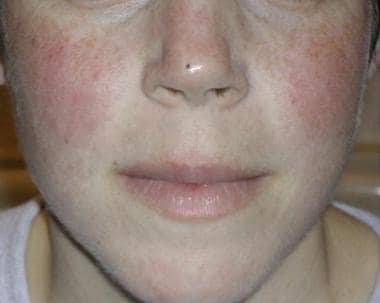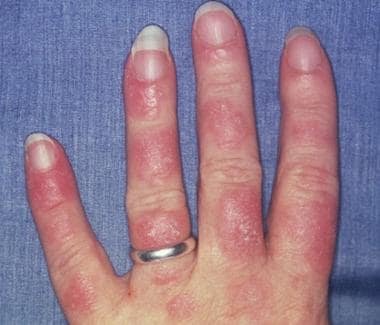Overview
Background
Systemic lupus erythematosus (SLE) is an inflammatory connective tissue disease with variable manifestations (eg, rash; see the images below). [1, 2, 3] SLE may affect many organ systems with immune complexes and a large array of autoantibodies, particularly antinuclear antibodies (ANAs). It is a disease characterized by relapses, flares, and remissions. Common manifestations, in addition to the malar rash, include cutaneous photosensitivity, nephropathy, serositis, and polyarthritis. The overall outcome of the disease is highly variable with extremes ranging from permanent remission to death. [4]
 The classic malar rash, also known as a butterfly rash, of systemic lupus erythematosus, with distribution over the cheeks and nasal bridge. Note that the fixed erythema, sometimes with mild induration as seen here, characteristically spares the nasolabial folds.
The classic malar rash, also known as a butterfly rash, of systemic lupus erythematosus, with distribution over the cheeks and nasal bridge. Note that the fixed erythema, sometimes with mild induration as seen here, characteristically spares the nasolabial folds.
 Photosensitive systemic lupus erythematosus rashes typically occur on the face or extremities, which are sun-exposed regions. Photo courtesy of Dr. Erik Stratman, Marshfield Clinic.
Photosensitive systemic lupus erythematosus rashes typically occur on the face or extremities, which are sun-exposed regions. Photo courtesy of Dr. Erik Stratman, Marshfield Clinic.
As with many chronic conditions, SLE adversely affects quality of life due to factors such as depression, pain, cognitive dysfunction, and sleep disturbances. [5]
Despite having a poorly understood etiology, fatigue is associated with SLE in approximately 80% of cases, which leads to a decreased level of physical fitness and, subsequently, decreased ability to perform activities of daily living. [6] Surveys of European SLE patients furthermore associate fatigue and burden to others as primary causes of decreased quality of life, impaired productivity, and hindered career choices. [5]
In addition to decreased isometric strength, premenopausal SLE patients have also been found to have less upper and lower body dynamic muscle strength, which is further associated with low functional performance, decreased quality of life, and fatigue. [6]
A study by Kinikli et al found that independent factors associated with whether patients with SLE have low (ability to walk less than 2 km) or high (ability to jog and run at least 2 km) physical capacity include age, body mass index, disease duration, the Systemic Lupus Activity Measure-Revised (SLAM-R) score, the Systemic Lupus International Collaborating Clinics-Damage Index (SLICC-DI) score, the International Physical Activity Questionnaire-Short Form (IPAQ-SF) category, sitting hours per day as measured through the IPAQ-SF, exercise over the past year, the Hospital Anxiety and Depression Scale (HADS) score, and the EuroQol visual analog scale (EQ-VAS) score. [7]
Physical medicine and rehabilitation for SLE may involve physical therapy, occupational therapy, speech therapy, recreational therapy, or combinations thereof. Follow-up medical care of patients with SLE must be ongoing. One physician should coordinate the patient’s care. The physician and the patient must be alert to subtle changes in symptoms that may indicate a flare-up in the disease process.
A study by Perandini et al reviewing postexercise levels of interleukin and soluble tumor necrosis factor receptor levels in women with SLE indicated, after comparison with healthy controls, that exercise has a homeostatic immunomodulatory effect in SLE. [8]
Treatment & Management
Physical therapy
Physical therapy (PT) is often beneficial for patients with systemic lupus erythematosus (SLE). [9] The role of the physical therapist is to assess each patient and to determine an effective plan of care to help reduce pain, stiffness, and inflammation, as well as to improve joint range of motion (ROM) and functional mobility. [10] Key points to keep in mind when developing a PT program for a patient with SLE include the following.
SLE is a disease with high individual clinical variability in presentation. Thus, exercises should be individualized. [11]
Individuals with SLE also have reported less overall exercise and lower exercise capacity when compared with controls. [12] Aerobic exercise might improve aerobic capacity in patients with mild SLE [13] and may also decrease overall fatigue. [14]
Arthritis is a common occurrence of SLE, with an incidence of 69-95%; however, it is usually less inflammatory than rheumatoid arthritis, although joint deformities may still occur. Arthritis in SLE occurs predominately in the hand and knee, yet most joints may be affected. [15] For patients with predominant arthralgias or arthritis, techniques used in rheumatoid arthritis may be helpful. [16] Incorporate isometric exercises for patients with joint inflammation, especially for the hip and knee (to help maintain biomechanical stability). [17] Isotonic exercises can be used when joint inflammation is reduced or absent. Transfers and ambulation activities are important for maintaining mobility.
Aerobic exercise has not been shown to aggravate disease activity in patients with low-to-moderate disease activity in SLE; however, this has not been well documented in patients with high disease activity. [13] A literature review by Del Pino-Sedeño et al indicated that aerobic exercise can reduce fatigue in adults with SLE. The investigators found, however, that the results of this intervention were not completely consistent across the instruments used in the report's studies. [18]
A literature review by Alexanderson and Boström found that in persons with mild/inactive SLE in whom low/no organ damage has occurred, there is moderately strong evidence that aerobic capacity can be improved with moderate-to-high–intensity aerobic exercise. The investigators also reported that there is limited evidence that such exercise can also improve fatigue and depressive symptoms in these patients. Actual disease activity was not found to be changed. [19]
Strengthening exercises are initiated when appropriate. [20] Fatigue may hinder progress in some patients. ROM exercises in the presence of inflammation may induce more pain. Isometric exercises may be better tolerated. [17] Hydrocollator packs can be helpful prior to completing ROM to help reduce pain and stiffness.
If pain lasts for more than 1-1.5 hours following activity, the exercise regimen should be reduced in intensity and/or duration.
Proper positioning may prevent joint contractures in patients with SLE. Do not use a pillow under a painful knee.
Ultrasonography (US) is a modality commonly used to provide deep heat to the affected joint, but it should not be used in the presence of inflammation; ice is the preferred modality for inflamed joints. When US is used to improve ROM, movement of the joint and the application of US should be simultaneous.
A pool, when available, is an excellent setting for exercising inflamed joints because of the buoyancy of the water (providing unloading of the joint) and the soothing quality of warm water.
The cardiovascular and pulmonary systems may also be affected in SLE. Pacing strategies are useful when severe cardiac and pulmonary problems are apparent. In addition to improving aerobic capacity, physical exercise may also improve endothelial function. [21] Abnormal breathing patterns during exercise may contribute to exercise intolerance, and respiratory exercises could be beneficial. [22]
Assistive devices, such as canes and walkers, are often helpful based on the patient’s individual needs.
Occupational therapy
The role of the occupational therapist (OT) is to help the patient regain as much of his or her functional independence as possible despite the problems caused by the disease. Principles of occupational therapy for patients with SLE include the following.
Activities of daily living (ADLs) are encouraged and may require training with special equipment, techniques, and procedures. ADLs include feeding, dressing, bathing, toileting, grooming, and homemaking. [23]
Adaptive equipment may be necessary for patients to complete ADL tasks; some of the more common adaptive equipment includes a raised toilet seat, splints, and reachers. Elastic (no-tie) shoelaces and wide-handled tools may increase the degree of independence.
Educating the patient in joint conservation techniques to protect the joints from damage is important. Paraffin baths are comforting for patients with hand involvement and may improve use.
As stated previously, fatigue is one of the most frequent and debilitating symptoms that must be dealt with in patients with SLE. The OT can be helpful in teaching the patient energy conservation techniques, frequently using adaptive equipment.
A home safety evaluation may be indicated. The OT can provide recommendations for equipment (eg, bathtub bench, raised toilet seat, grab bar) to increase the patient’s independence and safety with mobility at home.
Gentleness is important in all settings.
Speech therapy
Patients with neuropsychiatric SLE may also present with cognitive dysfunction, with deficits of executive skills, attention, language, memory, psychomotor speed, and visual-spatial processing. [24, 25]
The speech pathologist can be helpful when a patient with SLE has slurred speech, difficulty understanding speech, or difficulty speaking appropriately.
Evaluation by a speech pathologist may also be beneficial for patients with memory impairment, attention deficits, and visual-spatial rehabilitation. [15]
SLE patients with swallowing problems can also be evaluated and treated by the speech pathologist.
Recreational therapy
The role of the recreational therapist (RT) is to involve the SLE patient in enjoyable activities that have therapeutic value. For example, a patient who has painful or weak hands, may benefit from putting a jigsaw puzzle together, which is a light activity that enhances the patient’s eye-hand coordination and his/her ability to match pieces by color. Patients can do this while standing or sitting (whichever is most appropriate) and at the same time can be socializing with other patients.
Medications
Nonsteroidal anti-inflammatory drugs (NSAIDs) may be considered for symptomatic management of arthralgia, myalgia, and serositis; however, they should be used for short durations and caution should be used in patients with renal insufficiency, cardiac comorbidities, and risks for GI complications. [26]
Hydroxychloroquine is anti-inflammatory and immunomodulatory. It is useful for managing musculoskeletal and mucocutaneous issues and symptoms such as fatigue and fever. It may also be cardioprotective and reduce low-grade flares, thereby slowing disease progression. [26]
Corticosteroids have often been used in the treatment of SLE owing to their immunosuppressive and anti-inflammatory properties. In addition to topical applications for discoid lupus and certain rashes and oral/IV uses for mild-to-severe disease manifestations, intra-articular steroid injections may also be considered for joint involvement. Caution should be used when giving corticosteroids with NSAIDs owing to increased risk of GI ulceration. [26]
Immunosuppressive agents such as azathioprine and cyclophosphamide may be used in moderate-to-severe disease to further reduce organ damage and inflammation. These medications may also serve to decrease steroid use. Other agents are used in SLE work to deplete B cells or target T- and B-cell interaction to interfere with the immune cascade. [26]
-
The classic malar rash, also known as a butterfly rash, of systemic lupus erythematosus, with distribution over the cheeks and nasal bridge. Note that the fixed erythema, sometimes with mild induration as seen here, characteristically spares the nasolabial folds.
-
Photosensitive systemic lupus erythematosus rashes typically occur on the face or extremities, which are sun-exposed regions. Photo courtesy of Dr. Erik Stratman, Marshfield Clinic.
-
This axial, T2-weighted magnetic resonance imaging (MRI) brain scan demonstrates an area of ischemia in the right periventricular white matter of a 41-year-old woman with longstanding systemic lupus erythematosus. She presented with headache and subtle cognitive impairments but no motor deficits. Faintly increased signal intensity was also seen on T1-weighted images, with a trace of enhancement following gadolinium that is too subtle to show on reproduced images. Distribution of the abnormality is consistent with occlusion of deep penetrating branches, such as that which may result from local vasculopathy, with no clinical or laboratory evidence of lupus anticoagulant or anticardiolipin antibody. Cardiac embolus from covert Libman-Sacks endocarditis remains less likely, due to distribution.
-
Mesangial proliferative lupus nephritis with moderate mesangial hypercellularity. International Society of Pathology/Renal Pathology Society (ISN/RPS) 2003 class II (hematoxylin and eosin stain; 200X magnification).
-
Focal lupus nephritis, immunofluorescence. International Society of Pathology/Renal Pathology Society (ISN/RPS) 2003 class III (200X magnification).
-
Diffuse lupus nephritis with extensive crescent formation (rapidly progressive glomerulonephritis). International Society of Pathology/Renal Pathology Society (ISN/RPS) 2003 class IV (hematoxylin and eosin stain; 200X magnification).
-
Membranous lupus nephritis showing thickened glomerular basement membrane. International Society of Pathology/Renal Pathology Society (ISN/RPS) 2003 class V (silver stain; 200X magnification).







